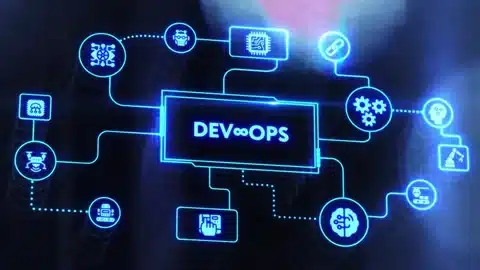Continuous Integration and Delivery: The Backbone of DevOps
In the world of software development and operations, Continuous Integration and Continuous Delivery (CI/CD) are more than mere buzzwords. They represent a transformative approach that accelerates software releases while ensuring quality and reliability.
Looking back, the software industry used to rely heavily on long development cycles. CI/CD evolved as a response to the need for more frequent and reliable software releases in an agile environment.

Table of Contents
Table of Contents
Why CI/CD is the Backbone of DevOps?
The rapid transformation of the software landscape is undeniable. Amidst this shift, CI/CD emerges as the unsung hero, fostering faster and more efficient releases. When talking about DevOps, which blends development and operations, CI/CD plays a central role in bridging the two domains. But why is CI/CD pivotal for DevOps?
Benefits of CI/CD in DevOps Context:
- Accelerated Release Cycles: Traditional release cycles, which often spanned weeks or even months, are significantly reduced, fostering a competitive edge.
- Enhanced Code Quality: With consistent integration and testing, errors are detected early, improving overall code robustness.
- Reduced Manual Errors: Automation minimizes manual interventions, leading to fewer human-induced errors.
- Streamlined Feedback Loop: Stakeholders receive prompt feedback, enabling quicker iterations.
CI/CD is thus not merely a methodology but the essence of DevOps. It not only expedites software delivery but ensures it’s of the highest quality.
Challenges in Implementing CI/CD
Transitioning to a CI/CD model is not without its hurdles. While the promise of swift releases and improved code quality is alluring, organizations often grapple with numerous challenges.
Hurdles faced during CI/CD Implementation:
- Initial Resistance: As with any significant change, resistance, especially from teams accustomed to traditional methods, is common.
- Inadequate Infrastructure: Setting up a robust CI/CD pipeline necessitates substantial infrastructure, which many organizations might lack.
- Security Oversights: Rapid releases might sometimes overshadow security protocols.
- Skill Gaps: Not every team member might be acquainted with CI/CD principles, leading to implementation hiccups.
Despite these challenges, with strategic planning, skilled personnel, and the right toolset, a smooth transition to CI/CD is achievable.
Key Tools in the CI/CD Pipeline
In the realm of CI/CD, tools are your best allies. The market is brimming with tools tailored for every CI/CD need. But selecting the right one is paramount for an optimized pipeline.
Top CI/CD Tools and Their Unique Features:
- Jenkins: Often dubbed the king of CI/CD, it’s open-source and boasts an extensive plugin ecosystem.
- GitLab CI: Beyond version control, GitLab CI offers a seamless CI/CD experience, all under one roof.
- Docker: With containerization taking center stage, Docker ensures applications run consistently across environments.
Equipped with the right tools, CI/CD implementation becomes a streamlined affair, ensuring continuous software delivery with minimized hitches.
Metrics to Monitor for CI/CD Success
Every CI/CD journey, while unique, shares common milestones. Keeping an eye on specific metrics can offer invaluable insights into your pipeline’s efficiency.
Key Metrics to Gauge CI/CD Efficacy:
- Deployment Frequency: A direct indicator of your release cadence.
- Change Lead Time: Time taken from code commit to deployment – the shorter, the better.
- Service Restoration Time: How swiftly can services be restored post an outage?
- Change Failure Rate: Measures the percentage of deployments causing a service outage.
Regularly monitoring these metrics ensures your CI/CD pipeline remains in optimal health, paving the way for software excellence.
The integration of CI/CD in the DevOps model redefines software development and deployment. It’s not just a technical enhancement; it’s a culture shift. As we embrace this synergy, we pave the way for innovative, high-quality, and efficient software solutions.
The transformative power of Continuous Integration and Continuous Delivery (CI/CD) in the DevOps landscape cannot be overstated. As we journeyed through the intricacies of this dynamic duo, it’s evident that they not only streamline software development processes but also foster a culture of continuous improvement. Embracing these practices can lead organizations to more agile, efficient, and error-free software deployments.
Are you ready to harness the combined power of CI/CD and DevOps?
Dive into this transformative approach and reshape your software delivery pipeline for unparalleled outcomes.
Harness the might of CI/CD and the ethos of DevOps for your business today. Take the insights from this article and embark on your software development transformation journey! Should you need expert guidance or DevOps consultation on implementation, reach out to us. Let’s innovate and elevate, together!
FAQ: Continuous Integration and Delivery
CI/CD bridges the developmental and operational aspects of software creation. By enabling consistent integration and automatic deployment, it reduces errors, enhances software quality, and speeds up releases, thus reinforcing the DevOps ethos of continuous enhancement.
Continuous Integration pertains to the frequent merging of code changes into a central repository, followed by automated tests. Continuous Delivery, on the other hand, ensures that these changes are automatically deployable to production without manual intervention.
While CI/CD is primarily associated with software development, its principles of automation, consistency, and quality assurance can be applied in other domains that require continuous updates and integration, such as content creation or database management.
CI/CD's emphasis on automation ensures consistent testing and integration. By detecting errors early in the development cycle and ensuring that only thoroughly tested code reaches production, software quality is significantly enhanced.
Yes, numerous tools cater to various CI/CD needs. Popular choices include Jenkins, GitLab CI, Docker, and Travis CI, among others. The selection often depends on an organization's specific requirements and existing tech stack.
Initially, the transition might require resource allocation for training, tool setup, and process restructuring. However, the long-term benefits, such as reduced manual errors, faster release cycles, and improved software quality, often outweigh the initial investment.
CI/CD promotes a culture of shared responsibility. Since code is consistently integrated and deployed, teams work collaboratively, ensuring that any code merged into the central repository is of the highest quality, thereby fostering an environment of collective accountability.
Some hurdles include resistance to change from traditional methods, inadequate infrastructure, potential security oversights in rapid releases, and skill gaps within the team. However, with strategic planning and the right resources, these challenges can be mitigated.
By enabling faster and more reliable software releases, CI/CD allows businesses to respond swiftly to market changes, gather user feedback in real-time, and improve products at a faster pace, leading to better customer satisfaction and potential market advantage.
Not at all. While tech giants and large organizations might have been early adopters, CI/CD principles are scalable and can be beneficial for startups and mid-sized enterprises, ensuring they remain competitive and agile in their software delivery processes.




